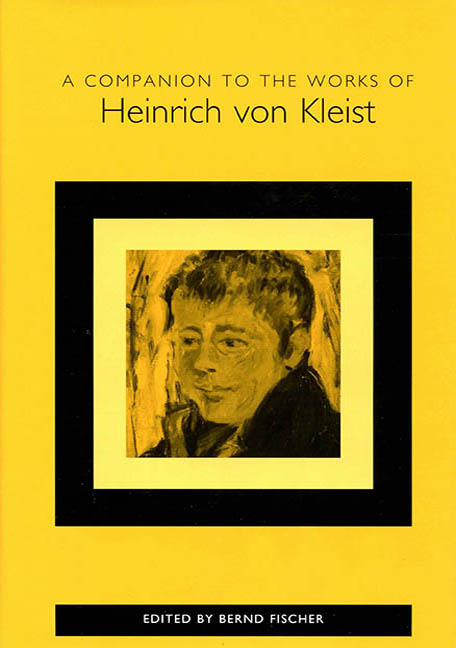Book contents
- Frontmatter
- Contents
- Introduction: Heinrich von Kleist's Life and Work
- Critical Approaches
- Language and Form
- Intellectual Paradigms
- Themes and Motifs
- Changing Color: Kleist's “Die Verlobung in St. Domingo” and the Discourses of Miscegenation
- Ripe Moments and False Climaxes: Thematic and Dramatic Configurations of the Theme of Death in Kleist's Works
- “Mein ist die Rache spricht der Herr”: Violence and Revenge in the Works of Heinrich von Kleist
- Notes on the Contributors
- Index
Ripe Moments and False Climaxes: Thematic and Dramatic Configurations of the Theme of Death in Kleist's Works
from Themes and Motifs
Published online by Cambridge University Press: 27 April 2017
- Frontmatter
- Contents
- Introduction: Heinrich von Kleist's Life and Work
- Critical Approaches
- Language and Form
- Intellectual Paradigms
- Themes and Motifs
- Changing Color: Kleist's “Die Verlobung in St. Domingo” and the Discourses of Miscegenation
- Ripe Moments and False Climaxes: Thematic and Dramatic Configurations of the Theme of Death in Kleist's Works
- “Mein ist die Rache spricht der Herr”: Violence and Revenge in the Works of Heinrich von Kleist
- Notes on the Contributors
- Index
Summary
Now more than ever seems it rich to die,
To cease upon the midnight with no pain,
While thou art pouring forth thy soul abroad
In such an ecstasy! (Keats, “Ode to a Nightingale”)
Ripeness and death are brought into a striking new relationship in the Romantic period. The terms Todeslust and Todessucht are familiar enough to us in the Baroque, but at that period they signify an entirely different approach to the theme of death. Death obtains a high rating in proportion to the low esteem in which life is held, the latter being variously regarded as a “Vale of Tears,” or a “Venusberg” offering vain distractions and illusory aspirations from which escape should be ardently sought in exchange for a blissful afterlife. Placed in a secular, post-Enlightenment world, the Romantic sensibility actively seeks to extract pleasure from the senses, to savor and offer itself up to a whole range of experiences in the here and now. John Keats's “Ode to a Nightingale” (1820) well expresses this hedonistic view, according to which such intensely pleasurable sensations include the anticipation of death itself (Keats 49–51). Instead of antitheses, life and death are, for the Romantic mind, a continuum, contemplation and anticipation of which produces such extreme emotions as ecstasy (“Wollust” and “Entzücken”). In a letter of 1807 Kleist himself refers to death as a “refrain” of life, by which, I think, he means a summation and carrying over of essential elements from the one to the other sphere. A manifold experience spread over the fullness of a lifetime is less important to the Romantic mind than the quality and intensity of this all-encompassing vision of death and life. Coincidentally, many Romantics did die young, among them Novalis, Kleist, and Keats, and it is of more than passing interest that these writers’ perception of life was tinged to some extent by an affirmation and anticipation of death. Paradoxically, this positive evaluation of death adds to and enriches the quality of life itself, death becoming, as it were, a property of life. In the case of Novalis's poem collection Hymnen an die Nacht (1800) this idea is taken to an extreme point and leads to an intermingling of life and death in the form of a “Liebestod,” a Romantic paradox that finds its fullest expression in Richard Wagner's opera Tristan und Isolde (1865).
- Type
- Chapter
- Information
- A Companion to the Works of Heinrich von Kleist , pp. 209 - 226Publisher: Boydell & BrewerPrint publication year: 2003



